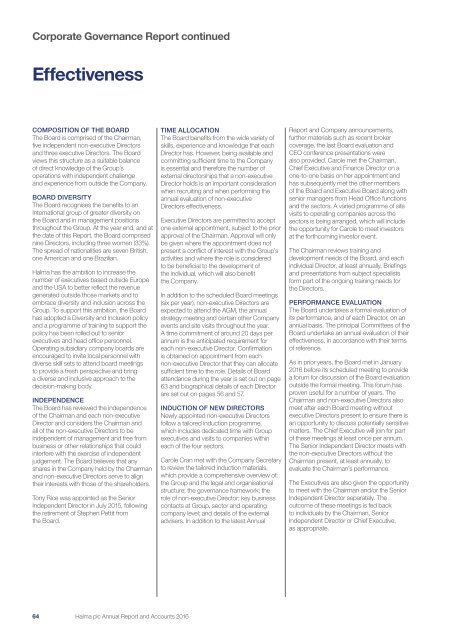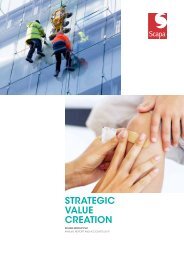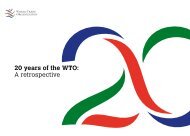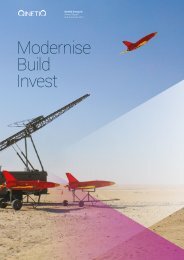Create successful ePaper yourself
Turn your PDF publications into a flip-book with our unique Google optimized e-Paper software.
Corporate Governance Report continued<br />
Effectiveness<br />
COMPOSITION OF THE BOARD<br />
The Board is comprised of the Chairman,<br />
five independent non-executive Directors<br />
and three executive Directors. The Board<br />
views this structure as a suitable balance<br />
of direct knowledge of the Group’s<br />
operations with independent challenge<br />
and experience from outside the Company.<br />
BOARD DIVERSITY<br />
The Board recognises the benefits to an<br />
International group of greater diversity on<br />
the Board and in management positions<br />
throughout the Group. At the year end, and at<br />
the date of this Report, the Board comprised<br />
nine Directors, including three women (33%).<br />
The spread of nationalities are seven British,<br />
one American and one Brazilian.<br />
<strong>Halma</strong> has the ambition to increase the<br />
number of executives based outside Europe<br />
and the USA to better reflect the revenue<br />
generated outside those markets and to<br />
embrace diversity and inclusion across the<br />
Group. To support this ambition, the Board<br />
has adopted a Diversity and Inclusion policy<br />
and a programme of training to support the<br />
policy has been rolled out to senior<br />
executives and head office personnel.<br />
Operating subsidiary company boards are<br />
encouraged to invite local personnel with<br />
diverse skill sets to attend board meetings<br />
to provide a fresh perspective and bring<br />
a diverse and inclusive approach to the<br />
decision-making body.<br />
INDEPENDENCE<br />
The Board has reviewed the independence<br />
of the Chairman and each non-executive<br />
Director and considers the Chairman and<br />
all of the non-executive Directors to be<br />
independent of management and free from<br />
business or other relationships that could<br />
interfere with the exercise of independent<br />
judgement. The Board believes that any<br />
shares in the Company held by the Chairman<br />
and non-executive Directors serve to align<br />
their interests with those of the shareholders.<br />
Tony Rice was appointed as the Senior<br />
Independent Director in July 2015, following<br />
the retirement of Stephen Pettit from<br />
the Board.<br />
TIME ALLOCATION<br />
The Board benefits from the wide variety of<br />
skills, experience and knowledge that each<br />
Director has. However, being available and<br />
committing sufficient time to the Company<br />
is essential and therefore the number of<br />
external directorships that a non-executive<br />
Director holds is an important consideration<br />
when recruiting and when performing the<br />
annual evaluation of non-executive<br />
Directors effectiveness.<br />
Executive Directors are permitted to accept<br />
one external appointment, subject to the prior<br />
approval of the Chairman. Approval will only<br />
be given where the appointment does not<br />
present a conflict of interest with the Group’s<br />
activities and where the role is considered<br />
to be beneficial to the development of<br />
the individual, which will also benefit<br />
the Company.<br />
In addition to the scheduled Board meetings<br />
(six per year), non-executive Directors are<br />
expected to attend the AGM, the annual<br />
strategy meeting and certain other Company<br />
events and site visits throughout the year.<br />
A time commitment of around 20 days per<br />
annum is the anticipated requirement for<br />
each non-executive Director. Confirmation<br />
is obtained on appointment from each<br />
non-executive Director that they can allocate<br />
sufficient time to the role. Details of Board<br />
attendance during the year is set out on page<br />
63 and biographical details of each Director<br />
are set out on pages 56 and 57.<br />
INDUCTION OF NEW DIRECTORS<br />
Newly appointed non-executive Directors<br />
follow a tailored induction programme,<br />
which includes dedicated time with Group<br />
executives and visits to companies within<br />
each of the four sectors.<br />
Carole Cran met with the Company Secretary<br />
to review the tailored induction materials,<br />
which provide a comprehensive overview of:<br />
the Group and the legal and organisational<br />
structure; the governance framework; the<br />
role of non-executive Director; key business<br />
contacts at Group, sector and operating<br />
company level; and details of the external<br />
advisers. In addition to the latest Annual<br />
Report and Company announcements,<br />
further materials such as recent broker<br />
coverage, the last Board evaluation and<br />
CEO conference presentations were<br />
also provided. Carole met the Chairman,<br />
Chief Executive and Finance Director on a<br />
one-to-one basis on her appointment and<br />
has subsequently met the other members<br />
of the Board and Executive Board along with<br />
senior managers from Head Office functions<br />
and the sectors. A varied programme of site<br />
visits to operating companies across the<br />
sectors is being arranged, which will include<br />
the opportunity for Carole to meet investors<br />
at the forthcoming investor event.<br />
The Chairman reviews training and<br />
development needs of the Board, and each<br />
individual Director, at least annually. Briefings<br />
and presentations from subject specialists<br />
form part of the ongoing training needs for<br />
the Directors.<br />
PERFORMANCE EVALUATION<br />
The Board undertakes a formal evaluation of<br />
its performance, and of each Director, on an<br />
annual basis. The principal Committees of the<br />
Board undertake an annual evaluation of their<br />
effectiveness, in accordance with their terms<br />
of reference.<br />
As in prior years, the Board met in January<br />
<strong>2016</strong> before its scheduled meeting to provide<br />
a forum for discussion of the Board evaluation<br />
outside the formal meeting. This forum has<br />
proven useful for a number of years. The<br />
Chairman and non-executive Directors also<br />
meet after each Board meeting without<br />
executive Directors present to ensure there is<br />
an opportunity to discuss potentially sensitive<br />
matters. The Chief Executive will join for part<br />
of these meetings at least once per annum.<br />
The Senior Independent Director meets with<br />
the non-executive Directors without the<br />
Chairman present, at least annually, to<br />
evaluate the Chairman’s performance.<br />
The Executives are also given the opportunity<br />
to meet with the Chairman and/or the Senior<br />
Independent Director separately. The<br />
outcome of these meetings is fed back<br />
to individuals by the Chairman, Senior<br />
Independent Director or Chief Executive,<br />
as appropriate.<br />
64 <strong>Halma</strong> plc Annual Report and Accounts <strong>2016</strong>

















